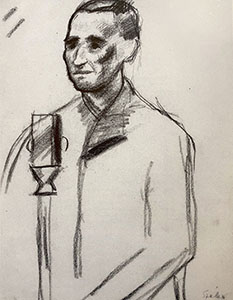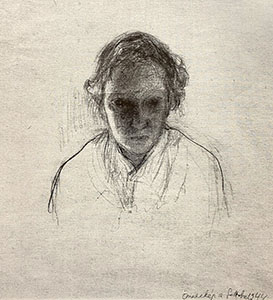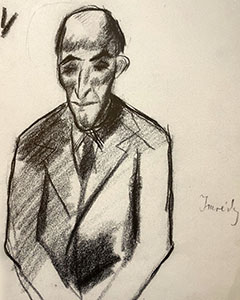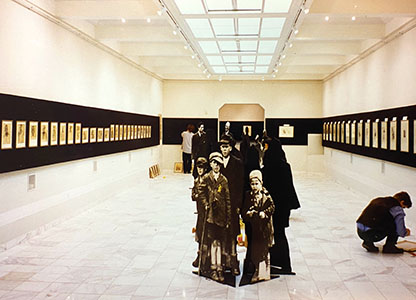
VICTIMS and PERPETRATORS
These two collections were created independently of each other and were never expected to survive or to be shown. The drawings are monuments to the approximately 600,000 Hungarian Jews who perished in concentration camps, forced labor camps, within the compound of yellow-star houses and ghettos, and shot into the Danube. Ilka Gedő started drawing sketches at the age of 18 in the ghetto. György Román, deaf from illness at an early age, hid under the floors in the homes of friends. Gedő sketched portraits of her fellow ghetto occupants as they huddled together in an overcrowded Budapest apartment house. Román drew sketches throughout the entire course of the Hungarian war criminal trials. Through their art, we see the beauty of the human condition juxtaposed with the horror of the Holocaust. The drawings’ poignant simplicity yield complex and dramatic effect, especially when seen now, decades later.
The Foundation opened the exhibition at the Budapest Jewish Museum followed by an exhibition at Yad Vashem, the World Holocaust Remembrance Center in Jerusalem, where Gedő ’s works remain in the Center’s permanent collection.
JEWISH MUSEUM, Budapest
(selected artworks)
Ilka Gedő
György Román
(photos) JEWISH MUSEUM, Budapest
“I want to assure you that I am especially grateful to you for launching this exhibition on a worldwide tour from the Jewish Museum of Budapest, the city where these works of art originated.”
--Arpad Goncz, former President of the Hungarian Republic
officially opening the exhibition
(life-size archival photo installations in the Jewish Museum)
YAD VASHEM
The World Holocaust Remembrance Center, Jerusalem
Ilka Gedő
György Román
(photos – Yad Vashem)
(excerpts from the Congressional Record)

“Mr. Speaker, I rise today to honor and commend Ms. Anita Semjen, Director of the Cultural Exchange Foundation, for her exceptional efforts in keeping alive the memories of the victims of the Holocaust. “Ms. Semjen demonstrates an admirable understanding of the arts and peoples of both the United States and Hungary. At a time when innocent people still fall victim to religious and ethnic persecution, Ms. Semjen’s exhibition rekindles our often passive conscience.
“Therefore, today, Mr. Speaker, more than fifty years after the tragedy of the Hungarian Holocaust, I invite my colleagues to join me in honoring the diligent efforts of Anita Semjen in reminding us of the grievous memories of the past and of the lessons history teaches us in the interminable fight against cruelty and oppression.”


































